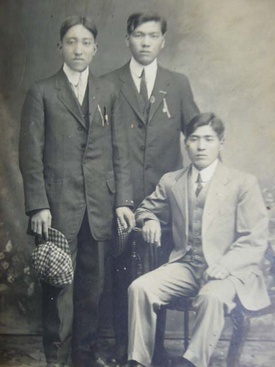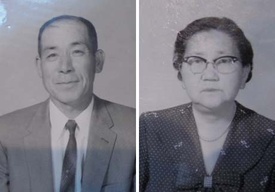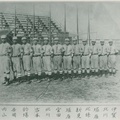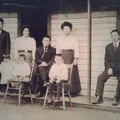The legendary Vancouver Asahi, strongest Nikkei baseball team before WWⅡ, was little known in Japan. However, their induction news in 2003 and 2005 became a hot topic in Japan. Yuya Ishii directed a film in Japanese, The Vancouver Asahi in 2014, on the centennial of its formation. The film premiered at the 2014 Vancouver International Film Festival and received the People's Choice award.
In Feb. 2011, three years ahead of the release of the film, there was an exhibition on immigration to North America in Hikone City, Shiga where many Asahi players were from. In the exhibition, a group photo of the Vancouver Asahi was displayed. One of the visitors immediately recognized one of the members labeled as “Unknown” as Yozaemon Kondo. It Yozaemon’s daughter, Sadako Kondo. She visited the exhibition with her son, Masayoshi Kondo.
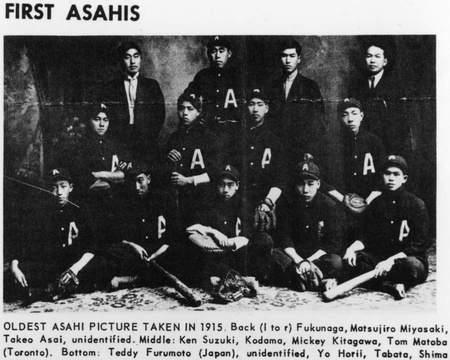
In 2014, Masayoshi happened to see The Vancouver Asahi film preview on TV which showed the same photo that he and his mother saw at the exhibition 3 years earlier. He searched the internet but could not find information about his grandfather and the Asahi team.
By chance, he read a newspaper article stating that another Asahi relative, Satoshi Matsumiya, was looking for family members of the Asahi, so he contacted Satoshi immediately. Since Satoshi Matsumiya was grandson of Sotojiro Matsumiya, early president of the Vancouver Asahi, he has searched for the Asahi families with me.
Masayoshi Kondo told me the family history of Yozaemon Kondo (1898ー1963).
Yozaemon Kondo was born in Hikone City as the eldest son of 4 brothers. His great grandfather Mohei was already in Canada and called his family over. Yozaemon immigrated to Vancouver with his family in 1911 after graduating from elementary school. He played in the Asahi Team from 1915-1916. At that time he worked in a sawmill. By the way, Masayoshi had never heard of the Vancouver Asahi from his grandfather, Yozaemon.
In 1922, he married Hana Hayashi (1902 – 1990), a picture bride from a place near Hikone. The couple’s first child (Fumiko) passed away at age three from an accident. Their second child, Sadako, was born in 1929 (died 2014). Sadako’s son is Masayoshi who was born in post-war Japan.
At that time, Yozaemon engaged in salmon fishing at Inverness Cannery, B.C., which was a hard work. His manager liked his work; Yozaemon eventually owned a ship as captain and worked with several fishermen.
In 1932, the family of three went to visit Japan. The day before they were scheduled to return to Vancouver, Yozaemon fell ill with heart failure. They remained in Japan for Yozaemon to recover. Around that time, Sadako lost her hearing.
At age 3, Sadako had an accident, falling from the second floor while Hana was preparing for meals to feed the fishermen. Although she ruptured her eardrum, Yozaemon and Hana thought it wasn’t serious. When Sadako was examined at Osaka University hospital, they found out that this accident was the reason of her hearing loss. The doctor told them that her hearing wouldn’t come back. They gave up going back to Canada and decided to stay in Japan forever. He sold his house and ships in Canada.
The Kondos moved from Hikone to Osaka in 1935 so that Sadako could go to a school for the deaf. Yozaemon borrowed money from his uncle and opened a Japanese sponge cake shop close to Sadako’s school in Osaka. His business was successful and he was able to return the money to his uncle—despite his uncle’s doubt that he would be able to repay the debt. As he was a very gentle and astute person, he was later elected the president of the business association.
In 1943-1944, however, the family had to evacuate to Hikone to avoid the war bombings in Osaka. During the Occupation of Japan, Yozaemon worked as an interpreter for the GHQ (General Head Quarters) of the Allied Forces. When the post war occupation ended, he returned to Osaka to rebuild his business. In addition to bread, Yozaemon started to manufacture cake and sell sweets. His business once again prospered.
In 1950, Sadako got married with Ryotaro (1930 – 1966), her uncle’s second son, and later had two sons: Masayoshi (born in 1952) and his younger brother, Yoshiji, (1955-2006).
In his later years, Yozaemon enjoyed watching cooking programs on TV and making a variety of dishes with those recipes for his family.
By the way, Yozaemon’s eldest sister, Ito Kondo, married Kanshiro Ohashi, also from Hikone City, who had a successful farm in Alberta. They had five children (3 sons and 2 daughters) who are all actively living in Canada. According to the New Canadian article on September 1,1989, Mr. and Mrs. Kanshiro Ohashi had 15 grandchildren and 6 great grandchildren. The eldest son was engaged in agriculture and was also a City council member. The second son was a successful farmer. Third son was a teacher. They were admired by all as an ideal Nikkei family.
I contacted the BC Sports Hall of Fame to share Yozaemon’s information. At that time, The Shin Asahi team planned to have a Japan tour. A member of the Shin Asahi directly handed the inductee medal to Masayoshi, Yozaemon’s grandson, on their visit to Hikone City in March 2015 during their tour. The Shin Asahi team was created in 2014 on the centennial of the formation of the original Vancouver Asahi to succeed the glorious team’s legacy.
The Kondo family in Japan and Ohashi family in Canada remain connected as relatives over the Pacific Oceans.
Thanks to the historical fame of the Vancouver Asahi, I am lucky to be able to get to know Yozaemon’s descendants, more than 100 years after the founding of the team.
© 2021 Yobun Shima



